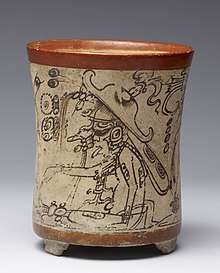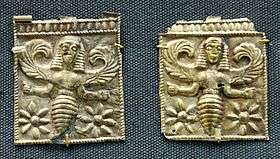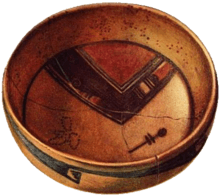Insects in mythology
Insects have appeared in mythology around the world from ancient times. Among the insect groups featuring in myths are the bee, fly, butterfly, cicada, dragonfly, praying mantis and scarab beetle.
Insect myths may present the origins of a people, or of their skills such as finding honey. Other myths concern the nature of the gods or their actions, and how they may be appeased. A variety of myths tell of transformations, such as between the soul of a living or dead person and a butterfly in Japan. Finally, insects appear as symbols of human qualities such as swiftness, or as portents of forthcoming trouble; accordingly, they may appear as amulets to ward off evil.
Myths of origin
The Kalahari Desert's San people tell of a bee that carried a mantis across a river. The exhausted bee left the mantis on a floating flower but planted a seed in the mantis's body before it died. The seed grew to become the first human.[1]
In Egyptian mythology, bees grew from the tears of the sun god Ra when they landed on the desert sand.[2] The bowstring on Hindu love god Kamadeva's bow is made of honeybees.[3]
The Baganda people of Uganda hold the legend of Kintu, the first man on earth. Save for his cow, Kintu lived alone. One day he asked permission from Ggulu, who lived in heaven, to marry his daughter Nambi. Ggulu set Kintu on a trial of five tests to pass before he would agree. For his final test Kintu was told to pick Ggulu's own cow from a stretch of cattle. Nambi aided Kintu in the final test by transforming herself into a bee, whispering into his ear to choose the one whose horn she landed upon.[4][5][6]
In Greek Mythology, Aristaeus was the god of bee-keeping. After inadvertently causing the death of Eurydice, who stepped upon a snake while fleeing him, her nymph sisters punished him by killing every one of his bees. Witnessing the empty hives where his bees had dwelt, Aristaeus wept and consulted Proteus who then proceeded to advise Aristaeus to give honor in memory of Eurydice by sacrificing four bulls and four cows. Upon doing so, he let them rot and from their corpses rose bees to fill his empty hives.[4][7]
In the Homeric Hymn to Aphrodite, the goddess Aphrodite retells the legend of how Eos, the goddess of the dawn, requested Zeus to let her lover Tithonus live forever as an immortal.[8] Zeus granted her request, but, because Eos forgot to ask him to also make Tithonus ageless, Tithonus never died, but he did grow old.[8] Eventually, he became so tiny and shriveled that he turned into the first cicada.[8]
Among the Australian aborigines, a tale tells how giant men found bee honeybags, and taught the aborigines how to find them.[9]
Gods and mortals
In an ancient Sumerian poem, a fly helps the goddess Inanna when her husband Dumuzid is being chased by galla demons.[10] Flies also appear on Old Babylonian seals as symbols of Nergal, the god of death[10] and fly-shaped lapis lazuli beads were often worn by many different cultures in ancient Mesopotamia, along with other kinds of fly-jewellery.[10] The Akkadian Epic of Gilgamesh contains allusions to dragonflies, signifying the impossibility of immortality.[11][12]
The Homeric Hymn to Apollo acknowledges that Apollo's gift of prophecy first came to him from three bee maidens, usually but doubtfully identified with the Thriae, a trinity of pre-Hellenic Aegean bee goddesses.[13] A series of identical embossed gold plaques were recovered at Camiros in Rhodes;[14] they date from the archaic period of Greek art in the seventh century, but the winged bee goddesses they depict must be far older.[15]
In Prometheus Bound, attributed to the Athenian tragic playwright Aeschylus, a gadfly sent by Zeus's wife Hera pursues and torments his mistress Io, who has been transformed into a cow and is watched constantly by the hundred eyes of the herdsman Argus. Shakespeare alludes to the myth:[16][17] "Io: Ah! Hah! Again the prick, the stab of gadfly-sting! O earth, earth, hide, the hollow shape—Argus—that evil thing—the hundred-eyed."[17]

In Hittite mythology, the god of agriculture, Telipinu, went on a rampage and refused to allow anything to grow and animals would not produce offspring. The gods went in search of Telipinu only to fail. Then the goddess Hannahannah sent forth a bee to bring him back. The bee finds Telipinu, stings him and smears wax upon him. The god grew even angrier, until the goddess Kamrusepa (or a mortal priest according to some references) used a ritual to send his anger to the Underworld.
In Hindu mythology, Parvati was summoned by the Gods to kill the demon Arunasura in the form of Bhramari Devi, who took over the heavens and the three worlds. She stings him to death with the help of innumerable black bees emerging from her body, and the Gods regain control.[18]

In ancient Egyptian religion, the sun god Ra is seen to roll across the sky each day, transforming bodies and souls. Beetles of the family Scarabaeidae (dung beetle) roll dung into a ball as food and as a brood chamber in which to lay eggs; this way, the larvae hatch and are immediately surrounded by food. For these reasons the scarab was seen as a symbol of this heavenly cycle and of the idea of rebirth or regeneration. The Egyptian god Khepri, Ra as the rising sun, was often depicted as a scarab beetle or as a scarab beetle-headed man. The ancient Egyptians believed that Khepri renewed the sun every day before rolling it above the horizon, then carried it through the other world after sunset, only to renew it, again, the next day.[19]
The mantis was revered in southern African Khoi and San traditions where man and nature were intertwined.[20] Several ancient civilizations considered the insect to have supernatural powers; for the Greeks, it had the ability to show lost travelers the way home; in the Ancient Egyptian Book of the Dead the "bird-fly" is a minor god that leads the souls of the dead to the underworld; in a list of 9th-century BC Nineveh grasshoppers (buru), the mantis is named necromancer (buru-enmeli) and soothsayer (buru-enmeli-ashaga).[21][22]
Transformations
According to Lafcadio Hearn, a butterfly was seen in Japan as the personification of a person's soul; whether they be living, dying, or already dead. If a butterfly enters your guestroom and perches behind the bamboo screen, it is said in Japan that the person whom you most love is coming to see you. Large numbers of butterflies are viewed as bad omens. When Taira no Masakado was secretly preparing for his famous revolt, there appeared in Kyoto so vast a swarm of butterflies that the people were frightened – thinking the apparition to be a portent of coming evil.[23]
Diderot's Encyclopédie similarly cites butterflies as a symbol for the soul. A Roman sculpture depicts a butterfly exiting the mouth of a dead man, representing the Roman belief that the soul leaves through the mouth.[24] Indeed, the ancient Greek word for "butterfly" is ψυχή (psȳchē), which primarily means "soul" or "mind".[25] According to Mircea Eliade, some of the Nagas of Manipur claim ancestry from a butterfly.[26] In some cultures, butterflies symbolise rebirth.[27] In the English county of Devon, people once hurried to kill the first butterfly of the year, to avoid a year of bad luck.[28] In the Philippines, a lingering black butterfly or moth in the house is taken to mean a death in the family.[29]
An Ancient Greek myth tells of the cithara player Eunomos ("Mr Goodtune"). During a competition, the highest string on his five-string cithara broke. At that moment, a cicada landed on the musical instrument and sang in the place of the missing string: together, they won the competition.[30]
An Australian aboriginal tale tells how a man builds a shelter for his sick son; when he returns with food, his son has vanished, but up in a tree is a cocoon around a pupa.[9]
Symbols, amulets and omens
Insects have often been taken to represent qualities, for good or ill, and accordingly have been used as amulets to ward off evil, or as omens that predict forthcoming events. A blue-glazed faience dragonfly amulet was found by Flinders Petrie at Lahun, from the Late Middle Kingdom of ancient Egypt.[31] During the Greek Archaic Era, the grasshopper was the symbol of the polis of Athens,[32] possibly because they were among the most common insects on the dry plains of Attica.[32] Native Athenians wore golden grasshopper brooches to symbolize that they were of pure, Athenian lineage and did not have any foreign ancestors.[32] In later times, this custom became seen as a mark of archaism.[32]
For some Native American tribes, dragonflies represent swiftness and activity; for the Navajo, they symbolize pure water. They are a common motif in Zuni pottery; stylized as a double-barred cross, they appear in Hopi rock art and on Pueblo necklaces.[33] Among the classical names of Japan are Akitsukuni (秋津国), Akitsushima (秋津島), Toyo-akitsushima (豊秋津島). Akitu or akidu are archaic or dialectal Japanese words for dragonfly, so one interpretation of Akitsushima is "Dragonfly Island".[34] This is attributed to a legend in which Japan's mythical founder, Emperor Jinmu, was bitten by a mosquito, which was then eaten by a dragonfly.[35][36] As a seasonal symbol in Japan, the dragonfly is associated with autumn,[37] and more generally dragonflies are symbols of courage, strength, and happiness, and they often appear in Japanese art and literature, especially haiku.[33]
In Europe, dragonflies have often been seen as sinister. Some English vernacular names, such as "horse-stinger",[38] "devil's darning needle", and "ear cutter", link them with evil or injury.[39] Swedish folklore holds that the devil uses dragonflies to weigh people's souls.[33] The Norwegian name for dragonflies is Øyenstikker ("eye-poker"), and in Portugal, they are sometimes called tira-olhos ("eyes-snatcher"). They are often associated with snakes, as in the Welsh name gwas-y-neidr, "adder's servant".[39] The Southern United States term "snake doctor" refers to a folk belief that dragonflies follow snakes around and stitch them back together if they are injured.[40]
See also
References
- Chrigi-in-Africa. "The First Bushman / San". Gateway Africa. Retrieved 30 March 2017.
- Kritsky, Gene (2015). The tears of Re : beekeeping in ancient Egypt. Oxford University Press. ISBN 978-0-19-936138-0.
- "Kama". Encyclopædia Britannica. Retrieved 9 March 2018.
His bow is of sugarcane, his bowstring a row of bees.
- McLeish, Kenneth (1996). Bloomsbury Dictionary of Myth. Bloomsbury. ISBN 978-0-7475-2502-8.
- "Kintu the Person vs Kintu the Legend". Retrieved 19 April 2014.
- "Kintu – The First Human in Buganda". Retrieved 19 April 2014.
- "Aristaeus". Retrieved 20 April 2014.
- DuBois, Page (2010). Out of Athens: The New Ancient Greeks. Cambridge, Massachusetts: Harvard University Press. pp. 51–53. ISBN 978-0-674-03558-4.
- "Use of Insects by Australian Aborigines". Cultural Entomology Digest. Insects.org (1). Archived from the original on 16 October 2012. Retrieved 4 April 2016.
- Black, Jeremy; Green, Anthony (1992). Gods, Demons and Symbols of Ancient Mesopotamia: An Illustrated Dictionary. The British Museum Press. pp. 84–85. ISBN 0-7141-1705-6.
- Gullan, P. J.; Cranston, P. S. (2009). The Insects: An Outline of Entomology. John Wiley & Sons. pp. 9–13. ISBN 978-1-4051-4457-5.
- Gullan, P.J.; Cranston, P.S. (2005). The Insects: An Outline of Entomology (3 ed.). Oxford: Blackwell Publishing. ISBN 1-4051-1113-5.
- Scheinberg, Susan 1979. "The Bee Maidens of the Homeric Hymn to Hermes". Harvard Studies in Classical Philology 83(1979), pp. 1–28.
- One was illustrated in a line drawing in Harrison 1922:443, fig 135
- Cook, Arthur Bernard. "The bee in Greek mythology" 1895 Journal of the Hellenic Society 15 pages 1–24
- Belfiore, Elizabeth S. (2000). Murder among Friends: Violation of Philia in Greek Tragedy. Oxford, England: Oxford University Press. p. 47. ISBN 0-19-513149-5.
- Stagman, Myron (11 August 2010). Shakespeare's Greek Drama Secret. Cambridge Scholars Publishing. pp. 205–208. ISBN 978-1-4438-2466-8.
- "The Devi Bhagavatam: The Tenth Book: Chapter 13". sacred-texts.com. Retrieved 26 March 2016.
- Ben-Tor, Daphna (1989). Scarabs, A Reflection of Ancient Egypt. Jerusalem: Israel Museum. p. 8. ISBN 965-278-083-9.
- "Insek-kaleidoskoop: Die 'skynheilige' hottentotsgot". Mieliestronk.com (in Afrikaans). Retrieved 9 October 2015.
- Prete, Frederick R.; Wells, Harrington.: Wells, Patrick H. (1999). "The Predatory Behavior of Mantids: Historical Attitudes and Contemporary Questions". In Prete, Fredrick R.; Wells, Harrington; Wells, Patrick H.; Hurd, Lawrence E. (eds.). The Praying Mantids. Johns Hopkins University Press. pp. 3–8. ISBN 978-0-8018-6174-1.CS1 maint: multiple names: authors list (link)
- "Mantid". Encyclopædia Britannica. Retrieved 30 July 2015.
- Hearn, Lafcadio (1904). Kwaidan: Stories and Studies of Strange Things. Dover. ISBN 0-486-21901-1.
- "Butterfly". Encyclopedia of Diderot and D'Alembert. Retrieved 1 April 2015.
- Hutchins, M., Arthur V. Evans, Rosser W. Garrison and Neil Schlager (Eds) (2003) Grzimek's Animal Life Encyclopedia, 2nd edition. Volume 3, Insects. Gale, 2003.
- Rabuzzi, M. 1997. Butterfly etymology. Cultural Entomology November 1997 Fourth issue online Archived 3 December 1998 at the Wayback Machine
- "Church Releases Butterflies as Symbol of Rebirth". The St. Augustine Record. Retrieved 8 September 2015.
- Dorset Chronicle, May 1825, reprinted in: "The First Butterfly", in The Every-day Book and Table Book; or, Everlasting Calendar of Popular Amusements, etc. Vol III., ed. William Hone, (London: 1838) p 678.
- "Superstitions and Beliefs Related to Death". Living in the Philippines. Retrieved 9 October 2015.
- Egan, Rory B (2011). "Cicadas in Ancient Greece. Ventures in Classical Tettigology". Cultural Entomology Digest (3).
- "Beads UC7549". Petrie Museum Catalogue. The Petrie Museum, UCL. Archived from the original on 16 September 2017. Retrieved 10 June 2015. There is a photograph in the catalogue; it is free for non-commercial usage.
- Roche, Paul (2005). Aristophanes: The Complete Plays: A New Translation by Paul Roche. New York City, New York: New American Library. p. 176. ISBN 978-0-451-21409-6.
- Mitchell, Forrest L.; Lasswell, James L. (2005). A Dazzle of Dragonflies. Texas A&M University Press. pp. 19–27, 38. ISBN 1-58544-459-6.
- Nussbaum, Louis Frédéric; Käthe Roth (2005). "Akitsushima". Japan Encyclopedia. Cambridge: Harvard University Press. p. 20.
- Nihonto
- 杉浦洋一 (Youichi Sugiura); John K. Gillespie (ジョン・K・ギレスピー) (1999). 日本文化を英語で紹介する事典: A Bilingual Handbook on Japanese Culture (in Japanese and English). 日本国東京都千代田区 (Chiyoda, JP-13): 株式会社ナツメ社 (Kabushiki gaisha Natsume Group). p. 305. ISBN 4-8163-2646-4. Retrieved 26 April 2010.CS1 maint: location (link)
- Baird, Merrily (2001). Symbols of Japan: Thematic Motifs in Art and Design. New York: Rizzoli. pp. 108–9. ISBN 0-8478-2361-X.
- Trueman, John W. H.; Rowe, Richard J. "Odonata: Dragonflies and Damselflies". Tree of Life. Retrieved 27 February 2015.
- Corbet, Phillip S. (1999). Dragonflies: Behavior and Ecology of Odonata. Ithaca, NY: Cornell University Press. pp. 559–561. ISBN 0-8014-2592-1.
- Hand, Wayland D. (1973). "From Idea to Word: Folk Beliefs and Customs Underlying Folk Speech". American Speech. 48 (1/2): 67–76. doi:10.2307/3087894. JSTOR 3087894.

